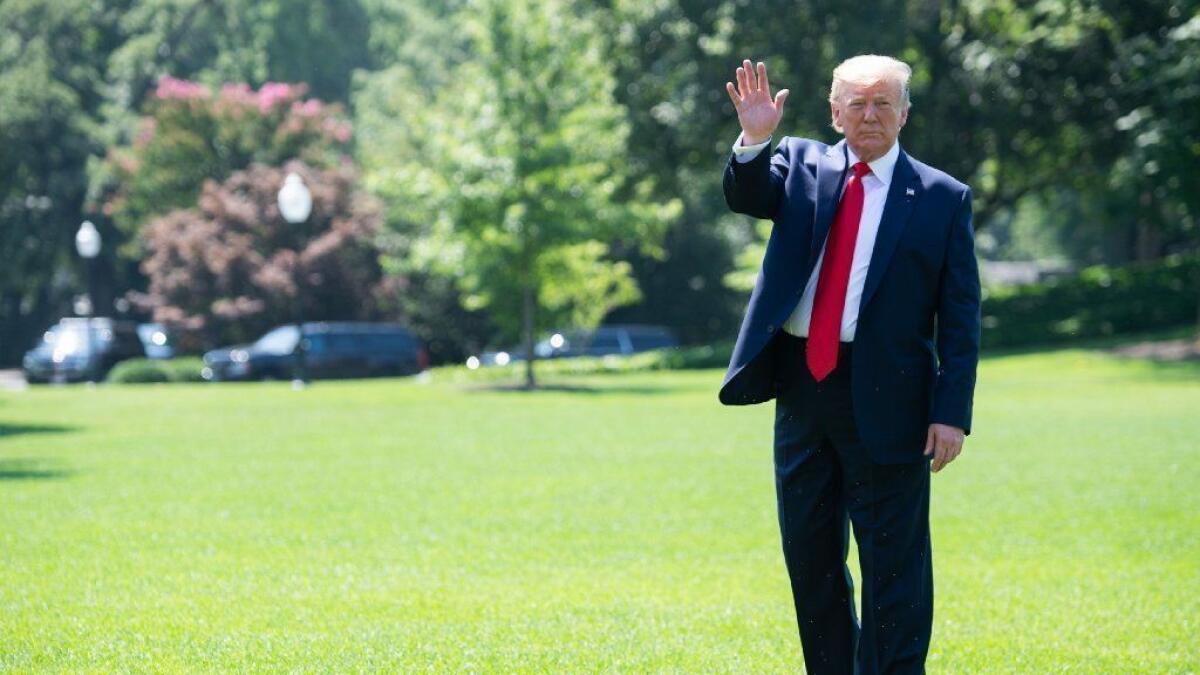Trump may add citizenship question to census with executive order, hoping to sway chief justice

President Trump said on Friday that he was considering several ways to add a citizenship question to the 2020 census, including by executive order, despite legal and logistical hurdles that could stop him.
The aim is to persuade Chief Justice John G. Roberts Jr. to change his mind and clear the way for Trump to proceed.
“We have four or five ways we can do it,” Trump told reporters at the White House. “We are working on a lot of different things, including an executive order.”
The president has been scrambling to revive the issue since the Supreme Court, by a 5-4 vote, blocked the new question on the grounds that Commerce Secretary Wilbur Ross failed to honestly explain why he sought to change census forms to ask all households about the citizenship of occupants for the first time since 1950.
Joined only by the court’s four liberal justices, Roberts said Ross’ explanation, which focused on enforcing the Voting Rights Act, “seems to have been contrived.”
Government lawyers saw the ruling as a defeat because they had told courts the deadline to begin printing the census forms was July 1.
However, the president said the chief justice’s opinion left the door open to try again, and that’s what he plans to do.
“I have a lot of respect for Justice Roberts. He did say: ‘Come back.’ Essentially, he said: ‘Come back.’ So we’ll see what happens. We can add an addition on. So we can start the printing now and maybe do an addendum after we get a positive decision,” Trump said.
It’s unclear whether the Commerce Department could actually add a citizenship question later this year — as Trump suggested — and what that might cost.
His comments came at the end of an extraordinary week that saw Justice Department lawyers and the Commerce secretary tell judges on Tuesday that the census would move ahead as planned, but without the citizenship question.
The next day, they were overruled by the president.
The issue carries broad ramifications for California and other states. Census experts predict millions of households — particularly those with immigrants — would refuse to fill out the form if the citizenship question were included. That in turn would lead to a severe undercut in California and other states with a high percentage of immigrants.
The Constitution calls for the “actual enumeration” of the population every 10 years and says the members of Congress will be allotted to the states “by counting the whole number of persons in each state.” It also says the census should be conducted “in such manner as [members of Congress] shall direct.”
Conservatives outside the administration, including former federal appeals court Judge J. Michael Luttig, have urged Trump to issue an executive order that reinstates the citizenship question.
“The census belonged to the president. Until [the Supreme Court decision], it did. He needs to get it back,” Hugh Hewitt, a former Justice Department lawyer, wrote in a Washington Post column two days after the Supreme Court’s decision.
It is not clear what new rationale the administration could cite as justification for adding the new question.
Some former officials have argued the government could say it needs better data on the number of immigrants who entered the country illegally, but the new census question would not supply that. It would ask residents to check a box if they are not a citizen of the United States. It is estimated that half of the noncitizens living in the United States are legal residents. Many are in the process of becoming citizens.
A more realistic possibility is the administration could say it needs citizenship data so states could redraw their election districts for the next decade based on the number of eligible voters, not the whole population. The Supreme Court in a 2015 case from Texas left open the question whether this was a legal option for states.
Trump on Friday also mentioned redistricting as one of the reasons the government needs to ask about citizenship.
But until recently, administration lawyers did not discuss this rationale, in part because its impact would favor Republicans in states such as Texas, Florida and Arizona and hurt Democrats.
Three federal judges — in New York, San Francisco and Maryland — heard lawsuits challenging the Commerce Department’s plan and all three issued orders that blocked the administration from proceeding. Those orders remain in place.
MALDEF, the legal advocacy group, represented immigrants-rights group in the Maryland case, and its president, Thomas A. Saenz, said Friday that he doubted Trump’s latest gambit would succeed.
“There is nothing magical about an executive order,” he said. “It still has to present a legitimate rationale. I think they are going through the motions, and ultimately they won’t be allowed to add the question.”
U.S. District Judge George Hazel in Maryland said he plans to consider further evidence that Ross and the Trump administration intended to discriminate against Latinos by undercutting their voting power. The Supreme Court did not rule on this issue, but Hazel could rule that adding the new question amounted to unconstitutional racial discrimination.
Saenz said such a ruling could further complicate Trump’s plans. “A finding of racial intent would override” the earlier rulings which were based on federal procedural law, he said. “It is difficult to see how the Supreme Court would weigh in on that now.”
More to Read
Get the L.A. Times Politics newsletter
Deeply reported insights into legislation, politics and policy from Sacramento, Washington and beyond. In your inbox three times per week.
You may occasionally receive promotional content from the Los Angeles Times.








